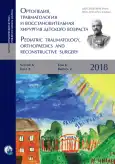Dependence of the 8-plate position inhemiepiphysiodesis on the X-ray parameters of the epimetaphyseal bone junction
- Authors: Kenis V.M.1, Morenko E.S.1, Sapogovsky A.V.1
-
Affiliations:
- The Turner Scientific Research Institute for Children’s Orthopedics
- Issue: Vol 6, No 2 (2018)
- Pages: 37-43
- Section: Original papers
- URL: https://ogarev-online.ru/turner/article/view/8987
- DOI: https://doi.org/10.17816/PTORS6237-43
- ID: 8987
Cite item
Abstract
Introduction. To correct axial deformities in children at the knee joint level, the method of “guided growth” using the 8-plate is applied. Despite the widespread use of this method, the toolkit for its implementation was developed mainly for patients with idiopathic deformities and does not take into account the features of the epimetaphyseal bone junction in children with skeletal dysplasias.
Aim. To develop X-ray criteria that characterize anatomical features of the epimetaphyseal region of the bone to predict possible difficulties associated with the position of the metal structure in hemiepiphysiodesis.
Materials and methods. We developed calculations of the X-ray parameters of the epimetaphyseal junction of the bone (angle of the epimetaphyseal junction and index of the epimetaphyseal junction) in 58 patients (107 lower limbs) with axial deformities in the frontal plane at the knee level in skeletal dysplasias (main group). The control group included 50 children (67 lower limbs) with identical deformities but without a primary lesion of the growth plate in which similar calculations of the X-ray parameters were performed. In stage I of the study, all patients were admitted to the Department of the Turner Research Institute for Children’s Orthopedics for temporary hemiepiphysiodesis using the 8-plate to correct axial deformities of the lower extremities at the knee joint level. In stage 2, the metal structure position was evaluated after the operative treatment that adhered the plate to the bone metaphysis. A total of 255 plates were fixed: the hemiepiphysiodesis of the femur was performed in 138 cases and of the tibia in 117. Pearson correlation coefficient analysis was performed by using IBM SPSS Statistics version 23 software.
Results. Among the patients who underwent surgical interventions using the method of guided growth, incomplete adherence of the plate to the bone was observed in 43 (17.3%) of 255 fixed plates because of the anatomical features of the epimetaphyseal region and more often in patients with skeletal dysplasias.
Conclusion. We developed X-ray criteria for the angle of the epimetaphyseal junction and the index of the epimetaphyseal junction that are recommended for prediction of the position of metal structures.
Full Text
##article.viewOnOriginalSite##About the authors
Vladimir M. Kenis
The Turner Scientific Research Institute for Children’s Orthopedics
Author for correspondence.
Email: kenis@mail.ru
ORCID iD: 0000-0002-7651-8485
MD, PhD, Associate Professor, Deputy Director for Development and International Relations, Head of the Department of Foot Surgery, Neuroortopedics and Skeletal Displasias.
Russian Federation, 64, Parkovaya str., Saint-Petersburg, Pushkin, 196603Ekaterina S. Morenko
The Turner Scientific Research Institute for Children’s Orthopedics
Email: emorenko@gmail.com
MD, PhD Student of the Department of Foot Surgery, Neuroortopedics and Skeletal Displasias
Russian Federation, 64, Parkovaya str., Saint-Petersburg, Pushkin, 196603Andrey V. Sapogovsky
The Turner Scientific Research Institute for Children’s Orthopedics
Email: sapogovskiy@gmail.com
MD, PhD, Senior Researcher of the Department of Foot Surgery, Neuroortopedics and Skeletal Displasias
Russian Federation, 64, Parkovaya str., Saint-Petersburg, Pushkin, 196603References
- Yilmaz G, Oto M, Thabet AM, et al. Correction of lower extremity angular deformities in skeletal dysplasia with hemiepiphysiodesis: a preliminary report. J Paediatr Orthop. 2014;34(3):336-345. doi: 10.1097/BPO.0000000000000089.
- Danino B, Rodl R, Herzenberg JE, et al. Guided growth: preliminary results of a multinational study of 967 physes in 537 patients. J Child Orthop. 2018;12(1):91-96. doi: 10.1302/1863-2548.12.170050.
- Моренко Е.С., Кенис В.М. Коррекция осевых деформаций коленного сустава у детей методом управляемого роста (обзор литературы) // Ортопедия, травматология и восстановительная хирургия детского возраста. – 2016. – Т. 4. – № 1. – С. 57–62. [Morenko ES, Kenis VM. Guided growth for correction of axial deformities of the knee in children: a literature review. Pediatric traumatology, Orthopaedics and Reconstructive Surgery. 2016;4(1):57-62. (In Russ.)]
- Stevens PM. Guided growth for angular correction: a preliminary series using a tension band plate. J Paediatr Orthop. 2007;27(3):253-259. doi: 10.1097/BPO.0b013e31803433a1.
- Goldman V, Green DW. Advances in growth plate modulation for lower extremity malalignment (knock knees and bow legs). Curr Opin Pediatr. 2010;22(1):47-53. doi: 10.1097/MOP.0b013e328334a600.
- Patwardhan S, Shah K, Shyam A, Sancheti P. Growth Modulation in Children for Angular Deformity Correction around knee — Use of Eight Plate. International Journal of Paediatric Orthopaedics. 2015;1(1):29-33.
- Stevens PM. Guided growth: 1933 to the present. Strategies Trauma Limb Reconstr. 2006;1(1):29-35. doi: 10.1007/s11751-006-0003-3.
- Boero S, Michelis MB, Riganti S. Use of the eight-Plate for angular correction of knee deformities due to idiopathic and pathologic physis: initiating treatment according to etiology. J Child Orthop. 2011;5(3):209-216. doi: 10.1007/s11832-011-0344-4.
- Stevens PM, Klatt JB. Guided growth for pathological physes: radiographic improvement during realignment. J Paediatr Orthop. 2008;28(6):632-639. doi: 10.1097/BPO.0b013e3181841fda.
- Zajonz D, Schumann E, Wojan M, et al. Treatment of genu valgum in children by means of temporary hemiepiphysiodesis using eight-plates: short-term findings. BMC Musculoskelet Disord. 2017;18(1):456. doi: 10.1186/s12891-017-1823-7.
- Stevens PM. The broken screw dilemma. J Pediatr Orthop. 2014;34(3):e5. doi: 10.1097/BPO.0b013e31829aaf1a.
Supplementary files










